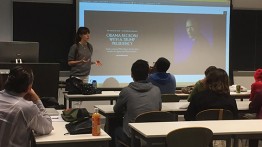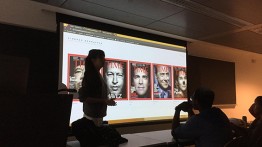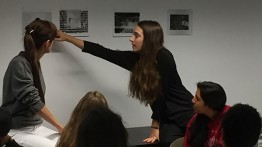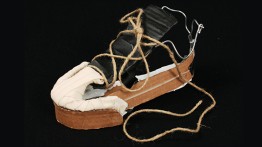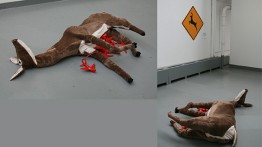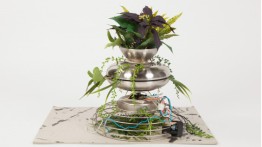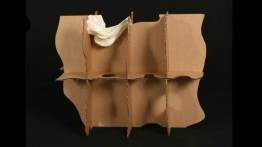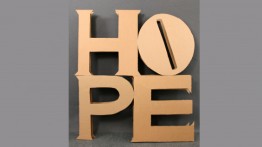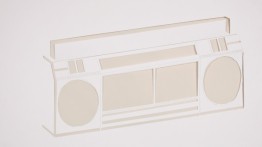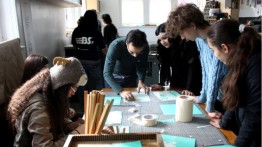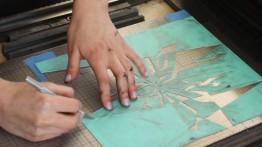Outreach Program Blog
Darkroom photography, Digital teenagers
POSTED ON: November 7, 2017

Every fall, the Cooper Outreach Pre-college program offers a darkroom photography class to 16 lucky (and talented) teenagers from the New York city area. Nowadays, when it comes to taking pictures, teenagers are more experienced and have more access than ever before. Just think about it – at least in the NYC area, it seems like the vast majority of teenagers have smartphones, and are adept at taking selfie after selfie and posting them to the requisite social-media site for their peers to review. But beyond knowing how to take a really well-styled arms-length self-portrait, and having a camera at their fingertips nearly all the time, are they aware of the mechanics of photographic reproduction? Or the possibilities for experimentation with light, coated paper, and chemicals in the traditional b&w darkroom?
Back when I was growing up (in the 90s), I was obsessed with taking photos. My first camera that was not actually my family’s camera was a thin purple plastic rectangle – a Mickey-Mouse branded 110mm point and shoot with a braided wrist strap. I LOVED my little camera, and the only thing more exciting than shooting photos of my cat, clouds, or views of the Pacific Ocean was getting the film developed and seeing what I had captured in the frame. Eventually my purple rectangle broke, and I moved on to a 35mm point and shoot hand me down from my parents. The stream of photos continued, as did arguments with my mom about the expense of getting photos developed and printed – back then you did it at the drug store.
And then, the summer of my 7th grade year, I went to a photo day camp at the Harvey Milk Photo Center (Part of the Parks&Rec Dept. of San Francisco). Within a few weeks, I had learned how to develop my own black and white photos. Even as a kid who had grown up obsessed with snapping away on a film camera, it was mind blowing to do the printing myself. There is an art to working with negatives, an enlarger, chemicals, and paper. We shot black and white 35mm film, worked with light and objects placed on photo paper to make photograms in the darkroom, and made pinhole cameras that took photos with a teeny hole projecting light directly onto a piece of photo paper stuck in the back of the camera.
In our photo class every fall, we use the same basic curriculum: the goal is to give the students hands-on experience with an art form that is not easily accessible to them in a high school art class. It sounds like it’s working – Amy Buckley, our photo teacher, has told me she’s had a hard time getting the students to leave the darkroom at the end of the 3-hour morning session so they can grab lunch before their afternoon classes! After my first darkroom photo class, I decided to save up and buy my own manual-focus 35mm camera. I still have and use that camera to this day.
Though teenagers today have the freedom to snap endless pictures on their phones without worrying about of the cost of developing the photos at Walgreens, and can develop their eye without getting into fights about the cost of prints with their parents, there is nothing that can substitute for the depth of understanding that comes from working hands-on in a darkroom, manipulating light on chemically treated paper. There is a magic in the darkroom that can’t be replaced with a computer screen and the latest version of Adobe. The Fall Outreach exhibition opens on November 14th, and will be on display in the 5th floor lobby of the Foundation building through the 17th. I can’t wait to see what our students have created in the darkroom!
Siobhán Bohnacker at Contemporary Art Issues Class
POSTED ON: October 23, 2017
Siobhán Bohnacker, a Senior Photo Editor for The New Yorker Magazine, came to speak to the Contemporary Art Issues class. She spoke about her work for the magazine commissioning original photography from such famed international photographers as Malick Sidibé, and producing numerous high profile shoots, including one with Barack Obama. Afterwards, instructor Amy Buckley joined Siobhan to critique student photography.
3-D Design
POSTED ON: January 26, 2017
Check out some examples of the work our students have done in the past in our 3D design class. Apply to our class this Spring! Learn more here
Letterpress Studio and the Winter Program 2017
POSTED ON: December 5, 2016
The Outreach Winter Program is an interdisciplinary class where students collaborate in the construction of what, at different times, has become an artist book of prints, a zine, or animated shorts. While the subject and format of the projects change from year to year, the common denominator is the printing presses at Cooper Union’s Letterpress Studio. This facility is equipped with four SP15 (Simple Precision) Vandercook presses that easily allow for large edition printing, and that combine rich ink saturation and a tactile quality on the paper.
Students work in small groups to collaborate on a concept and visualization. This is an opportunity to work towards a common goal, opening the single students point of view to include that of others, which proves to be a challenge for an otherwise very individual practice of self-expression. It takes a great effort to interpret and respond to the infinitely varied and complex issues that arise from our daily encounters with nature, with the city, and its inhabitants. What is at stake is not for students to simply make beautiful works of art, but to learn to point those visual skills in a clear direction.
The 2017 Winter Program will travel to the Brooklyn Botanical Garden to look at the underlying issues that occur in its green house conservatory. In these temperature-controlled environments, we will question notions around collecting, nomenclature, and the picturesque. In an attempt to replicate nature, the garden organizes what is seen and how it is seen, for the consumption of its visitors. As we capture an already displaced flora with a camera, we post it online, enlarge it, crop it, give it a hash tag, and so on. Our task will be to take a step away from this chain of motivations, to objectively reclaim our place in it through drawing, photography and writing. Students will use the format of an accordion book to create a visual experience layered by relief printing, photography and writing. In turn, everyone will leave with a limited edition artist book encompassing their own work and that of their peers.
Written by Pablo Diaz, who will be teaching letterpress. Amy Buckley will be the photography instructor, and Alex Velozo will poetry and drawing. We thank our special partnership with Ava Smile’s for making the poetry component possible.

